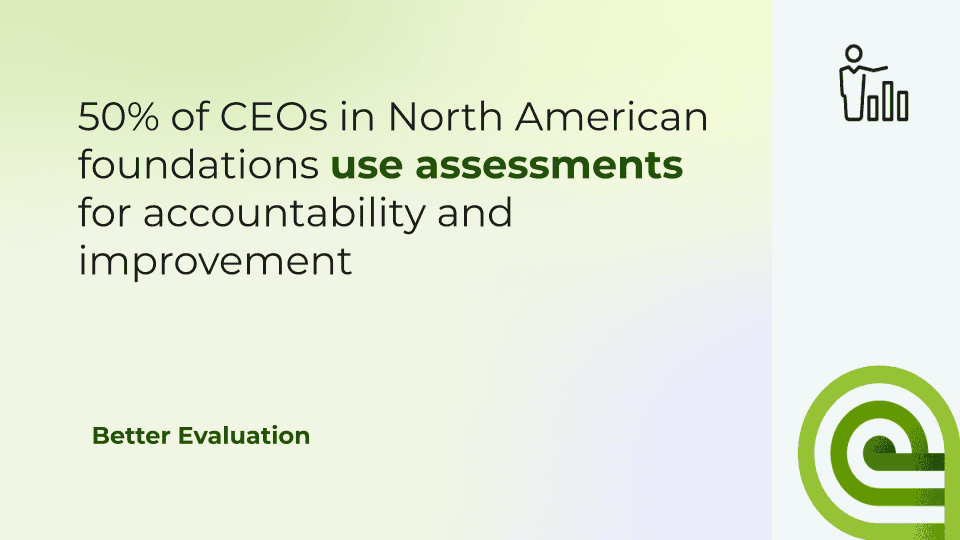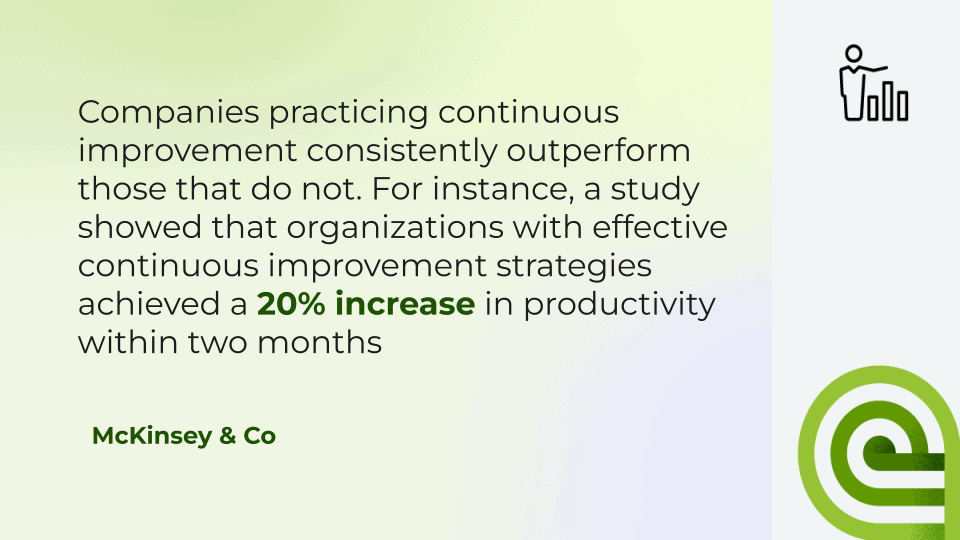
Utilizzo di benchmark di settore per massimizzare l'efficacia delle risorse.

Organizations must continuously seek ways to optimize resource utilization and enhance overall effectiveness. Achieving this requires a systematic approach that includes identifying industry benchmarks, assessing current performance, conducting gap analysis, developing targeted action plans, and implementing a continuous improvement cycle.
This article provides you with a step-by-step framework for evaluating and improving resource effectiveness within your organization. By following these steps, you can not only enhance operational efficiency but also align performance with industry standards, ultimately driving strategic success and fostering a culture of continuous improvement.
Step 1: Benchmark identification
Step 2: Current performance assessment
Step 3: Gap analysis
Step 4: Action plan development
Step 5: Implementation and monitoring
Step 6: Continuous improvement cycle
Let’s start!
Step 1: Benchmark identification
To accurately evaluate and improve resource effectiveness within an organization, it is essential to identify relevant industry benchmarks. These benchmarks provide a standard against which the organization’s resource utilization, productivity, and overall effectiveness can be measured.
By comparing against these benchmarks, the organization can gain insights into areas for improvement and set realistic performance targets.
Action steps for gathering industry benchmarks
- Define benchmark criteria:
- Start by identifying the specific metrics related to resource utilization, productivity, and effectiveness that are most relevant to your organization’s sector and size. These criteria will guide the selection of appropriate benchmarks.
- Utilize a digital platform for research:
- Use the platform to conduct thorough research on industry benchmarks. This includes accessing industry reports, market research studies, and databases that provide detailed benchmarking data for similar organizations.
- Compile comprehensive benchmarks:
- Gather and compile a comprehensive set of industry benchmarks, ensuring they cover a broad range of metrics such as resource allocation efficiency, output per employee, cost-effectiveness, and time management. Ensure these benchmarks are specific to the organization’s sector to ensure relevance.
- Verify benchmark relevance:
- Cross-check the gathered benchmarks to ensure they apply to your organization’s size and operational context. Discard any data that does not align with your specific characteristics or strategic goals.
- Integrate benchmarks into the platform:
- Integrate the selected benchmarks into the platform, creating a centralized repository that is easily accessible to stakeholders. This repository should be organized for easy reference and comparison with the organization’s internal metrics.
- Training and communication:
- Train relevant employees and managers on how to access and utilize the benchmark data. Communicate the importance of these benchmarks in driving improvements and setting performance targets.
- Regularly update benchmarks:
- Establish a process for regularly updating the benchmarks to ensure they remain current and reflective of industry trends. This includes periodically reviewing new industry reports and adjusting the benchmarks in the repository as needed.
By systematically gathering and compiling industry benchmarks related to resource utilization, productivity, and effectiveness, your organization can establish a robust framework for performance comparison. This process ensures that benchmarks are relevant to your organization’s sector and size, providing valuable insights for continuous improvement.
Regularly updating these benchmarks and integrating them into the platform enables ongoing alignment with industry standards, supporting strategic decision-making and driving organizational excellence. Through diligent application of these benchmarks, organizations can set realistic performance targets, identify areas for enhancement, and ultimately achieve greater resource effectiveness.
Step 2: Current performance assessment
To gain a comprehensive understanding of your organization’s current resource effectiveness, it is essential to analyze performance data across various departments and functions. By measuring this data against identified industry benchmarks, you can pinpoint areas of strength and opportunities for improvement.
Action steps for assessing resource effectiveness
- Collect performance data:
- Use a technical assessment platform, like TalentScore di DevSkiller, to gather current performance data from all relevant departments and functions. This data should include metrics related to resource allocation, productivity, efficiency, and cost-effectiveness.
- Organize and categorize data:
- Organize the collected data into categories that align with the identified industry benchmarks. Ensure that the data is comprehensive and covers all aspects of resource utilization within the organization.
- Benchmark comparison:
- Measure your organization’s performance data against the industry benchmarks compiled earlier. Use the platform to facilitate this comparison, highlighting how your metrics stack up against standard industry performance.
- Identify areas of strength:
- Analyze the comparison results to identify areas where your organization is performing well relative to industry benchmarks. Document these strengths as best practices to be maintained and possibly expanded upon.
- Highlight opportunities for improvement:
- Identify areas where your organization’s performance lags behind the industry benchmarks. Highlight these areas as opportunities for improvement, focusing on specific metrics that indicate underperformance.
- Generate actionable insights:
- Use the platform to generate reports that present the analysis findings in a clear and actionable format. These reports should include detailed insights on both strengths and areas needing improvement, along with recommendations for targeted actions.
- Engage stakeholders:
- Share the findings with key stakeholders, including department heads and senior management. Engage them in discussions to prioritize improvement initiatives and develop action plans based on the analysis.
- Implement improvement strategies:
- Develop and implement strategies to address the identified opportunities for improvement. This could involve reallocating resources, enhancing training programs, adopting new technologies, or refining processes to boost efficiency and productivity.
By leveraging the platform to analyze current performance data and measure it against industry benchmarks, organizations can gain a clear and detailed understanding of their resource effectiveness. This process highlights both areas of strength and opportunities for improvement, enabling the organization to make informed decisions and implement targeted strategies.

Regular benchmarking and analysis ensure continuous alignment with industry standards, fostering a culture of excellence and driving ongoing performance improvements. Through diligent assessment and strategic action, your organization can enhance it’s resource utilization, improve productivity, and achieve their operational and strategic goals more effectively.
Step 3: Gap analysis
To optimize organizational performance and align with industry standards, it is crucial to identify gaps between current performance and established benchmarks. Conducting a gap analysis using a skills management platform’s analytical tools can help pinpoint specific areas where your organization falls short or excels, providing clear direction for improvement or investment.
Action steps for conducting a gap analysis
- Gather performance data:
- Use the platform to collect detailed performance data from various departments and functions within the organization. This data should encompass metrics such as productivity, resource utilization, efficiency, and cost-effectiveness.
- Compile industry benchmarks:
- Ensure that the industry benchmarks relevant to your organization’s sector and size are compiled and integrated into the platform. These benchmarks serve as the standard against which current performance will be measured.
- Conduct the gap analysis:
- Leverage the platform’s analytical tools to compare your organization’s performance data against the industry benchmarks. This analysis should highlight specific areas where performance is below, meets, or exceeds industry standards.
- Identify areas of underperformance:
- Pinpoint specific metrics and functions where your organization falls short of industry benchmarks. Document these areas as key gaps that need to be addressed to improve overall performance.
- Highlight areas of excellence:
- Identify metrics and functions where your organization excels and performs above industry standards. Recognize these areas as strengths that can be leveraged or further enhanced.
- GenerateGenerating detailed reports:
- Use the platform to generate comprehensive reports that present the findings of the gap analysis. These reports should include clear visualizations, such as charts and graphs, to illustrate performance gaps and strengths.
- Develop action plans:
- Based on the gap analysis, develop targeted action plans to address areas of underperformance. These plans should include specific improvement initiatives, timelines, and resource allocations.
- Engage stakeholders:
- Share the gap analysis findings and action plans with key stakeholders, including department heads and senior management. Engage them in discussions to ensure alignment and support for the proposed initiatives.
- Implement and monitor improvements:
- Implement the improvement initiatives and use the platform to monitor progress. Regularly review the effectiveness of these initiatives and make adjustments as needed to ensure continuous improvement.
By using the platform’s analytical tools to conduct a thorough skill gap analysis, your organization can clearly identify specific areas where you fall short of or exceed industry benchmarks. This targeted approach provides a clear focus for improvement and strategic investment, enabling you to enhance performance, optimize resource utilization, and maintain competitive advantage.
Step 4: Action plan development
After identifying performance gaps through a comprehensive analysis, it is essential to develop targeted action plans to address these gaps effectively. Facilitating strategy sessions through the platform enables teams to collaboratively create detailed action plans that leverage best practices and innovative solutions to enhance resource effectiveness.
Action steps for developing targeted action plans
- Organize strategy sessions:
- Use the platform to schedule and organize strategy sessions with key stakeholders and team members from relevant departments. Ensure that these sessions are well-structured and focused on addressing specific performance gaps identified in the analysis.
- Collaborative brainstorming:
- Facilitate collaborative brainstorming sessions where teams can discuss the identified gaps and explore potential solutions. Encourage participants to share their insights, experiences, and innovative ideas for bridging these gaps.
- Leverage best practices:
- Identify and integrate industry best practices and successful strategies from within your organization. Use the platform to gather and share examples of effective solutions that have been implemented in similar contexts.
- Develop detailed action plans:
- Collaboratively create detailed action plans that outline specific steps to address each identified gap. These plans should include clear objectives, assigned responsibilities, timelines, and required resources.
- Incorporate innovative solutions:
- Encourage teams to consider innovative approaches and technologies that can enhance resource effectiveness. This process could involve adopting new tools, optimizing existing processes, or exploring creative problem-solving techniques.
- Set measurable goals:
- Establish measurable goals and key performance indicators (KPIs) for each action plan. These metrics will help track progress and evaluate the effectiveness of the implemented strategies.
- Review and refining plans:
- Use the platform to review and refine the action plans collaboratively. Ensure that all stakeholders have the opportunity to provide feedback and suggest adjustments to optimize the plans.
- Implement action plans:
- Execute the developed action plans, ensuring that all team members understand their roles and responsibilities. Use the platform to monitor progress, communicate updates, and address any challenges that arise during implementation.
- Continuous monitoring and evaluation:
- Regularly monitor the progress of the action plans using the platform’s tracking and reporting tools. Evaluate the outcomes against the set goals and KPIs, and make necessary adjustments to ensure continuous improvement.
By facilitating strategy sessions through the platform, your organization can collaboratively develop targeted action plans that address identified performance gaps. This structured approach ensures that the action plans are comprehensive, practical, and aligned with the organization’s strategic objectives. Leveraging best practices and innovative solutions enhances the effectiveness of these plans, driving improvements in resource utilization and overall performance.

Regular monitoring and evaluation ensure that the implemented strategies remain effective and adaptable to changing circumstances. Through collaborative planning and execution, organizations can successfully bridge performance gaps, optimize resource effectiveness, and achieve sustained success.
Step 5: Implementation and monitoring
Once detailed action plans have been developed to address identified performance gaps, the next critical step is to implement these plans and monitor their progress. Using a digital platform to manage the execution of these initiatives ensures that progress is tracked systematically and performance is continuously compared against industry benchmarks, driving the desired outcomes.
Action steps for implementing and monitoring action plans
- Initiate implementation:
- Use the platform to kick off the implementation of the action plans. Ensure that all team members understand their roles and responsibilities and have access to the necessary resources and tools.
- Set up milestone tracking:
- Establish clear milestones for each action plan and input these into the platform. Milestones should be specific, measurable, achievable, relevant, and time-bound (SMART) to facilitate effective tracking.
- Assign tasks and responsibilities:
- Assign specific tasks to team members and use the platform to track task completion. Ensure that responsibilities are clearly defined and that team members are held accountable for their contributions.
- Continuous progress monitoring:
- Leverage the platform’s tracking tools to monitor progress against the set milestones. Regularly update the status of tasks and milestones to provide a real-time view of how the initiatives are progressing.
- Compare performance against benchmarks:
- Continuously compare your organization’s performance against industry benchmarks using the platform’s analytical tools. This comparison helps ensure that the implemented initiatives are driving improvements and aligning with industry standards.
- Identify and address issues:
- Use the platform to identify any issues or roadblocks that arise during implementation. Address these challenges promptly by reallocating resources, adjusting timelines, or modifying strategies as needed.
- Regular status updates and reviews:
- Schedule regular status update meetings to review progress with all stakeholders. Use the platform to share progress reports, discuss any deviations from the plan, and make informed decisions about next steps.
- Adjust action plans as necessary:
- Be prepared to adjust action plans based on ongoing feedback and performance data. Use the platform to document and communicate any changes to ensure everyone remains aligned and informed.
- Evaluate outcomes:
- At the conclusion of the implementation period, evaluate the outcomes of the action plans against the original goals and benchmarks. Use the platform to generate detailed reports that highlight successes, areas for further improvement, and lessons learned.
By using the platform to manage the execution of improvement initiatives, organizations can ensure systematic implementation and effective monitoring of progress. Tracking progress against set milestones and continuously comparing performance against industry benchmarks allows for real-time adjustments and informed decision-making.
This structured approach helps ensure that initiatives drive the desired outcomes, enhancing resource effectiveness and aligning performance with strategic goals. Through diligent management and continuous evaluation, your organization can achieve sustained improvements and maintain a competitive edge.
Step 6: Continuous improvement cycle
To maintain and enhance resource effectiveness, your organization must embed a cycle of continuous improvement. This process involves regularly reviewing industry benchmarks and the organization’s performance relative to these benchmarks.
Establishing a mechanism within the platform for these reviews and encouraging ongoing adjustments ensures that strategies and practices evolve with industry standards and organizational needs.
Action steps for embedding continuous improvement
- Establish a review mechanism:
- Use the platform to set up a mechanism for regular reviews of industry benchmarks and organizational performance. This should involve scheduled intervals for data collection, analysis, and reporting.
- Integrate benchmarks and performance data:
- Ensure that the platform continuously integrates updated industry benchmarks and the organization’s performance data. This integration allows for seamless comparison and real-time analysis.
- Schedule regular review sessions:
- Schedule regular review sessions using the platform, involving key stakeholders and team members. These sessions should focus on evaluating current performance against industry benchmarks and identifying areas for improvement.
- Analyze performance data:
- Leverage the platform’s analytical tools to analyze performance data in detail. Identify trends, patterns, and deviations from industry standards that highlight areas requiring attention.
- Document insights and recommendations:
- Document the insights gained from these reviews and develop actionable recommendations for improving resource effectiveness. Use the platform to store and share these documents with relevant stakeholders.
- Implement strategic adjustments:
- Encourage teams to make ongoing adjustments to strategies and practices based on the review findings. Use the platform to manage the implementation of these changes, ensuring that they are aligned with your organization’s goals and industry standards.
- Track improvements:
- Continuously track the impact of implemented changes on resource effectiveness. Use the platform to monitor progress and measure improvements against both past performance and industry benchmarks.
- Promote a culture of continuous improvement:
- Promote a culture of continuous improvement by encouraging open communication and feedback. Use the platform to facilitate discussions on best practices, innovative solutions, and ongoing performance enhancement.
- Regular benchmark updates:
- Stay current with evolving industry standards by regularly updating the benchmarks in the platform. Ensure that your organization’s performance metrics are always compared against the most relevant and up-to-date benchmarks.
By establishing a robust mechanism within the platform for regular reviews and continuous adjustments, organizations can embed a cycle of continuous improvement in resource effectiveness. This approach ensures that your organization remains aligned with industry standards and adapts to changing conditions.

Final word
Implementing a structured approach to evaluate and improve resource effectiveness is essential for maintaining competitiveness and achieving operational excellence. Follow these steps: identify benchmarks, assess current performance, conduct a gap analysis, develop an action plan, implement and monitor progress, and embed a continuous improvement cycle.
Begin with benchmark identification to set clear performance standards. Assess current performance against these benchmarks to highlight strengths and areas for improvement. Conduct a gap analysis to pinpoint specific opportunities for optimization.
Develop detailed action plans involving all stakeholders to address identified gaps. Implement and continuously monitor these plans using a digital platform for real-time tracking and adjustments. Embed a continuous improvement cycle to stay agile and responsive to industry trends, fostering ongoing enhancement.
By following these steps, your organization can enhance resource effectiveness, boost productivity, and maintain a competitive edge. This holistic approach drives immediate performance improvements and supports long-term strategic goals, leading to sustained success and operational excellence.
Ready to discover how DevSkiller can elevate your approach to maximize resource effectiveness? Watch our video demo today and see firsthand the transformative power of our multi-vendor testing ecosystem.




